MechSE’s Leon Liebenberg, SIIP Team Use Play-in-Learning Elements to Engage Students, Foster Active Learning
“It’s stuff that the kids can associate themselves with much, much more easily, because that’s the language they talk.” – Leon Liebenberg
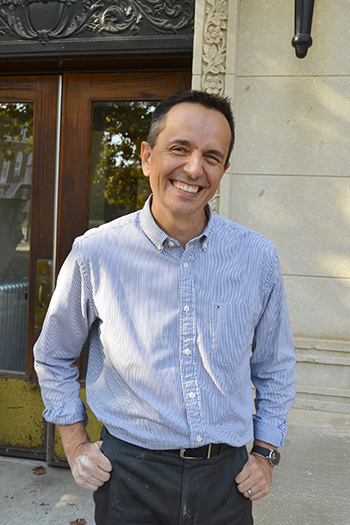
MechSE Professor Leon Liebenberg
September 19, 2018
We’ve all seen toddlers learn about shapes by trying to place a round object into a toy’s square hole, and vice versa. We’ve also seen children learn basic structural engineering principles by building a tall tower of blocks or Legos with insufficient structural support, only to have it crash to the floor. If small children can learn through play, couldn’t much older students, such as undergraduates in Illinois Engineering courses? Leon Liebenberg, a MechSE Professor, and a team of colleagues who are part of his “Play-in-Learning: Cognition, Emotion, and Playful Pedagogy” SIIP proposal all seem to think so.
Liebenberg reports, however, that “Not everyone is convinced that play belongs in engineering…Some people are cynical or suspicious about the prospective benefits of play in engineering.”
So, starting Fall 2018 semester, supported by funds from the College of Engineering’s AE3 (Academy for Excellence in Engineering Education) Strategic Instructional Innovations Program (SIIP) and matching funds from Mechanical Science and Engineering (MechSE), Liebenberg and a team of cohorts intend to collect data and construct a matrix that explains what was effective and what wasn’t in a number of their engineering classes implementing various play-in-learning techniques. Their goal is to determine if play-based learning activities indeed foster higher-order thinking and problem-solving skills.
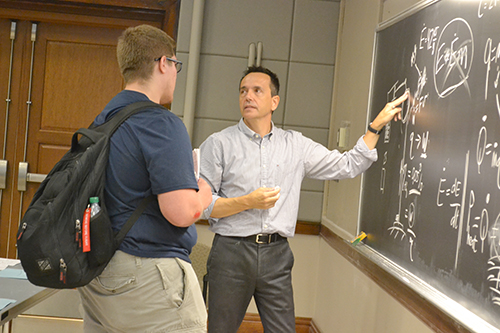
Professor Leon Liebenberg explaining a manufacturing principle to a student after class.
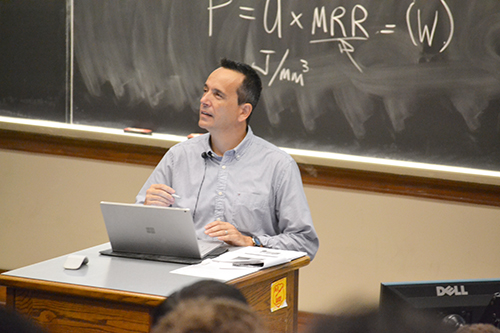
Professor Leon Liebenberg teaching his ME270 course.
In addition to Liebenberg, the SIIP team includes a number of professors, plus experts in curriculum, teaching and learning, and evaluation: Geoffrey Challen (Computer Science); Patricia Franke (Electrical and Computer Engineering), Chad Lane (Educational Psychology); Shelly Schmidt (Food Science and Human Nutrition / Agricultural and Biological Engineering); MechSE professors Elif Ertekin, Emad Jassim, Blake Johnson, Alex Pagano, and Sam Tawfick; as well as Robert Baird and Ava Wolf from CITL (Center for Innovation in Teaching and Learning). The courses include: CS 125, FSHN 101, ME 200 (previously ME 300), ME 270, ME 310, ME 320, and ME 370, impacting @1500 students in total.
Exactly what is Play in Learning? Rather than a learning style comprised solely of rote memorization or poring over textbooks hour after hour, the idea is to encourage students to explore engineering principles about something they’re interested in, then report on it using a medium that speaks their language, like animation; augmented, virtual, or mixed reality; online graphic novels; role-play; game-based response systems; and/or low-fidelity prototyping. Students literally "play" with their ideas!
Liebenberg explains why the SIIP project is needed: “No one knows what the long-term benefits are of using playful elements in class. We know the students enjoy it; we know the lecturers enjoy it. When I have fun, I relax more and learn easier, faster. I retain stuff longer. I don’t need a neuroscientist to tell me; this is just the experience I’ve had. But neuroscience does back it up.”
So the goal is to gather data regarding the impact on students of the playful methodologies they’re investigating—a matrix that says: “This playful element is typically suited for that, that, and that,” Liebenberg suggests. “It’s certainly not applicable for that. Do not even try it; it’s not gonna’ work.”
This matrix will hopefully enable folks in Engineering to say, “Ok, games are effective. They’re not a magic silver bullet, but they can help in certain areas of the curriculum,” Liebenberg adds.
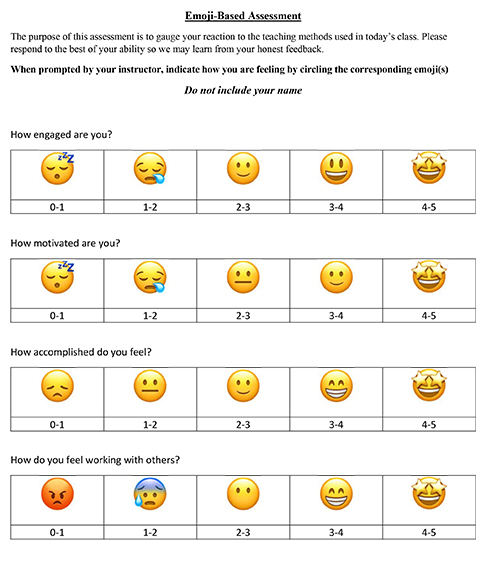 An emoji assessment developed by Liebenberg's SIIP team
An emoji assessment developed by Liebenberg's SIIP teamSo as part of Liebenberg's data collection process, his SIIP team has developed an emoji questionnaire (to the right) and a “Live Tweet” assessment to assess students’ emotions during playful, in-class activities. “Even the student assessment forms are in playful format,” he admits. “If you’re working with people’s emotions, then I guess it makes sense to use tools that are emotive!”
Liebenberg’s goal in using play in instruction is to get students to connect at an emotional level with the subject contents. “‘What do you feel? What are your emotions?’ If I can get a student to connect at an emotional level with a subject content, I sleep like a baby at night,” he says, then adds, “If people are happy, they connect emotionally much better with the topic than someone who’s highly stressed, which blocks positive emotions.”
So Liebenberg is implementing learning through play in the two MechSE courses he’s teaching this fall. ME 200, Thermodynamics, which he calls a theory-rich course, has no labs. However, students will be taking a number of field trips: Harley-Davidson in Champaign, Mack’s Recycling Yard, and Abbott Power Plant, where they will learn principles about thermodynamics. They will also visit Professor Emeritus Ty Newell’s “green” house that’s totally off the grid. It has thick walls made of recycled foam, solar panels, direct solar heating, and also heat pumps. Plus, Newell not only produces most of the electricity his home uses from the sun, but sells some back to the grid. Students will also visit Newell’s factory, which manufactures the world’s first integrated air conditioner/ventilation system which automatically brings in fresh air to address gray building syndrome. Students will analyze the systems both in Newell’s house and his factory from a thermodynamic point of view. Then the students are to develop a final project related to one of the above field trips. They will develop virtual or augmented reality apps or online videos.
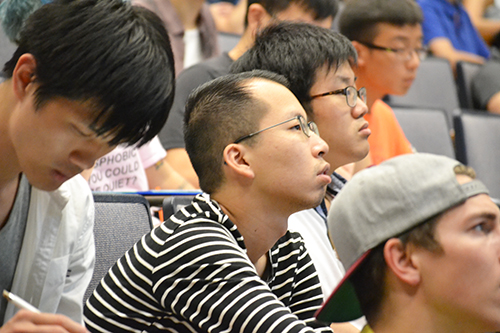 Above and below: ME270 students learn about different manufacturing methods.
Above and below: ME270 students learn about different manufacturing methods.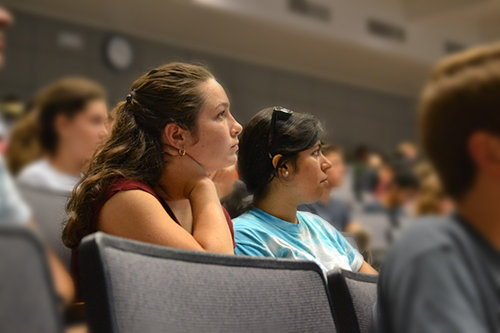
His second course, ME 270, Design for Manufacturability, has 15 labs in total. The idea behind this course is to design things that are simpler, use fewer parts, are easier to assemble or disassemble, can be made more inexpensively, and are easier to recycle. (Whether or not Liebenberg would term himself as “green,” he is quite conscientious regarding making sure the engineers he’s training take into consideration making things better for the environment.)
Liebenberg’s teaching pedagogy for the two courses is as easy as A, B, C: Autonomy, Brotherhood, and Competence. “This is what works for me in my teaching environment and learning environment,” he stresses.
The idea behind autonomy is to allow students to choose from among a number of projects that he’s described briefly, which he calls ill-defined. “Because I want the students to throw in their flavor,” he stresses. “‘Bring me your passions; bring me your interests, your skills.’”
His goal in regards to giving students so much autonomy is to give them self-directedness: “I’m literally giving the ball back to them and saying, ‘Ok, I want the game to be played like this. Stick to the rules. play the game however you want!’ And they’re happy doing it, and they love it.”
He underscores the importance of student autonomy: “You have to make sure the students take charge,” he explains. “If you want to do your thing and play the puppet master, it’s going to fall flat.”
To emphasize the brotherhood aspect of his teaching pedagogy, Libenberg uses teamwork: “They’re working in teams, as brothers and sisters together,” he explains. “They learn from each other…’I see things a certain way; you see things another way. We learn things from one another.’”
Plus, he attempts to construct effective teams comprised of students with diverse thinking styles by administering a learning preferences questionnaire, on which students must circle three attributes that best describe themselves, plus answer the open-ended question: “What important truth do very few people agree with you on?” Based on the results of this questionnaire, he structures teams, ensuring that each has a mix of students who have different personality types—analytic, innovative, procedural, relational—but may be passionate about similar things. In fact, one team’s responses to the open-ended question may possibly hint at each student’s personality type:
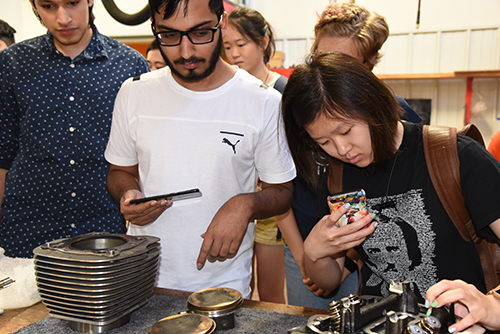
Students investigate different mechanical parts during a visit to Harley-Davidson. (Photo courtesy of Leon Liebenberg.)
- “People would live in a virtual world if it was better.” (Innovative?)
- “Sometime it’s important to let things go.” (Relational?)
- “I’m good at learning things that I’m totally unfamiliar with.” (Procedural?)
- “Aerospace is cooler than Mechanical Engineering and SpaceX is the best ever! (Analytic?)
“This mix-up of personalities works like a bomb to get the creative juices flowing,” he admits. He says it also leads to some friction in the first few weeks of team meetings, until students “learn the value of really listening to others, valuing others’ opinions, and respecting others.”
Regarding his third tenet—competence—how do his students show it, either individually and/or in groups? Liebenberg acknowledges that he’s not a big fan of tests (although he does administer them) because of the demoralizing effect a bad grade can have on students. While he scores their projects, he says even more important is the sense of fulfillment gained by a job well done.
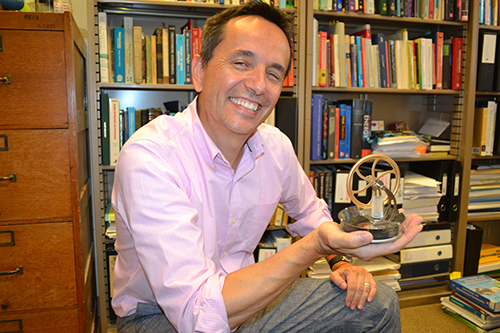
Professor Leon Liebenberg shows off a small Stirling engine that is powered by a tea light candle His students are now playing with the idea of using such an engine to lift a quarter a height of 2 m, in 10 minutes, using only a tea light candle.
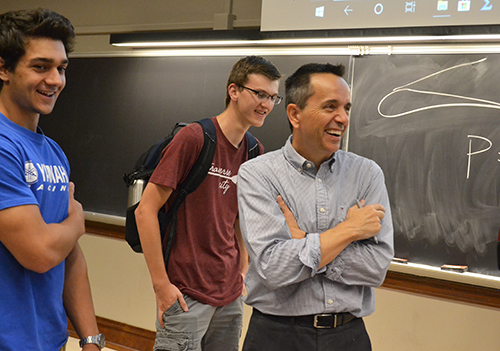
Liebenberg (right) interacts with some ME270 students.
“Because if I give you a test, and you get 10%, you’re going to feel very, very bad. But if I give you a project which you can cover in your own way, but with your friend’s help, and if you produce this really cool, mind-blowing virtual reality app, or graphic novel, or whatever, you’re going to feel so good about it.”
He also believes his students find braggin’ rights to be much more rewarding even than a high score on their project. “If I give you 90%, that’s gonna’ mean something. But the thumbs up you’re gonna’ get on social media, that’s gonna’ do better than a check box about competence—much more than any exam can do, I believe.”
This is not to say that Liebenberg doesn’t use conventional scoring methods; he administers assessments, but with a fun twist. For instance, he uses technology to administer quizzes. But rather than iClicker, he’s been using Kahoot, which makes it a competition. “People want their names at the top of the list, but you can only see the top 5 students,” he says. He gets all the data, and at the end of the semester, he’ll give an award to the student who’s the best quizzer.
He also employs technology to compensate for the large class sizes, which, at times, he finds daunting. “I get it, 40,000 students, it’s hard!” Then he goes on to acknowledge, “We’re so out of touch with our students. I can’t even remember all my students’ names. I can’t deal effectively with 320 students. I remember really good ones and really bad ones.”
So Liebenberg has discovered that using playful elements, like Kahoot, helps him to connect with his students. “We are at such a state of disconnect with our students,” he admits, saying to himself, “What can I do to reconnect? Can I use technology? I bet I can. If I can use a game like Kahoot to make students a little bit happier, I would. It motivates them, makes them feel good, with purpose.”
And of course, the technology pièce de résistance of his two courses is the virtual or augmented reality and/or graphic novels. Why virtual reality, for instance? Liebenberg claims that his students like apps. “They’re totally into VR and AR. They use words and terminology I haven’t even heard of. They are so comfortable with these media.”
He believes that because his students are passionate about the medium, they’re going to learn.
“But if it engages them here, and if I can use artificial or augmented reality or virtual reality as a means of connecting with them as the heart level, to teach them about thermodynamics, I’ve reached my goal. Because at the same time, I can help them appreciate things about the environment and about sustainable living.”
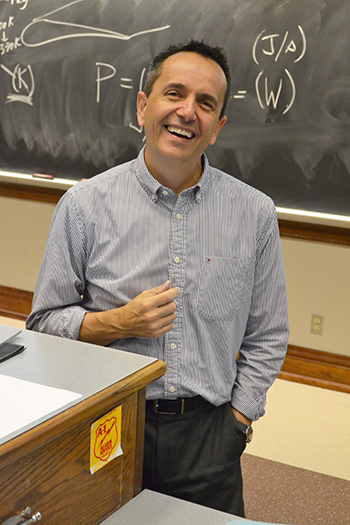
Professor Leon Liebenberg.
To help with some of the technology aspects, he’s partnering with PNX Labs in Germany, which will use the students’ ideas to make the AR and VR apps for free—as well as testing concepts in CITL’s Virtual Reality lab.
Regarding the benefits for all the partners of this collaboration, Liebenberg claims, “It’s a win-win, really, for everyone.”
For example, the University is interested in the collaboration for intellectual reasons—to help our students learn—and is also “happy that industry is willing to offer to open their doors for our students.” Plus, as an added bonus, all the apps and online graphic novels will display the Illinois logo, to promote the branding. Engineering, of course, will get data regarding the instructional benefits of learning in play.
PNX Labs will gain name recognition and new apps. A fairly unknown new startup, it doesn’t currently have any engineering apps, and is trying to get into the market. So they’re offering free services now so they can get their brand established, plus they get fully functional apps that they can make available in their library to sell to clients.
“They’re using us; we know this,” Liebenberg admits, regarding the start-up. “They’re using us and the university’s good name to get into the playing field.” Again, it's a win-win for all.
What’s in it for the students? They not only learn the subject matter, but they get to interact with industry—the local companies, but also with the engineers at PNX Labs. But even more important are the braggin’ rights. They get to boast to their family and friends, “I was part of this team!” He reports that his Chinese students were particularly excited about working with Harley Davidson. "That’s the cool American brand where they come from!”
Regarding his liberal use of the various playful elements and technology, he claims:
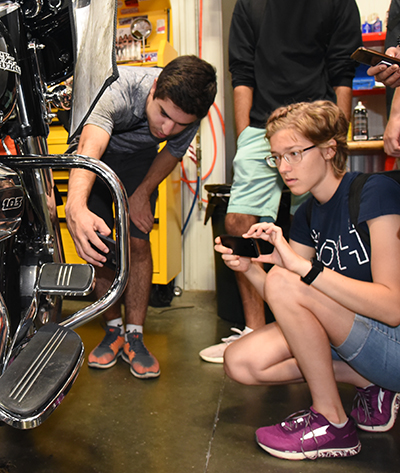
Students check out a motorcycle during a tour of a local Harley Davidson shop. (Photo courtesy of Leon Liebenberg.)
“It’s just stuff. It’s just a medium,” says Liebenberg. “But it’s stuff that the kids can associate themselves with much, much more easily, because that’s the language they talk. We want to get closer to the skateboard language and less to the other stuff that intimidates students. More about things that they perceive as being cool.”
For some graphical novels by Liebenberg's students, see:
- A Stirling Adventure by Justin Frank, Connor Latham, Vera Liu, & Michelle McCord
- Slothermo by Blake Banks, Sheikh Farhan, Nathan Griffin, & Milos Popovic
Story by Elizabeth Innes, Communications Specialist, I-STEM Education Initiative. Photographs by Elizabeth Innes unless otherwise noted.
Other I-STEM articles about MechSE courses:
- ME370’s Final Competition—March of the Automata—Fosters MechSE Students’ Creativity, Perseverance, and Teamwork
- ME370 Students Find End-of-the-Semester Robot Races a Fun Learning Experience
- ME370's Drench-Your-Professor Competition Creates a Splash
- ME 370's Unique "Drench Your Professor" Competition Hones Students' Design Skills
More: Faculty Feature, Liebenberg, MechSE, Undergrad, 2018
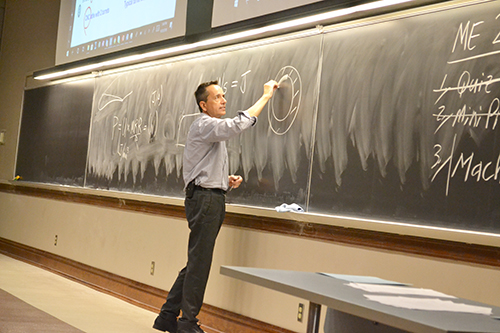
Professor Leon Liebenberg explaining something on the board while teaching his ME270 course.
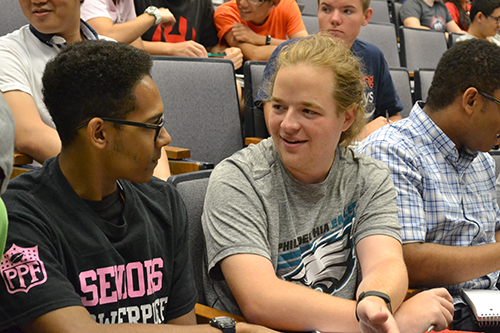
Two students put their heads together to come up with a solution about a manufacturing issue during ME270.
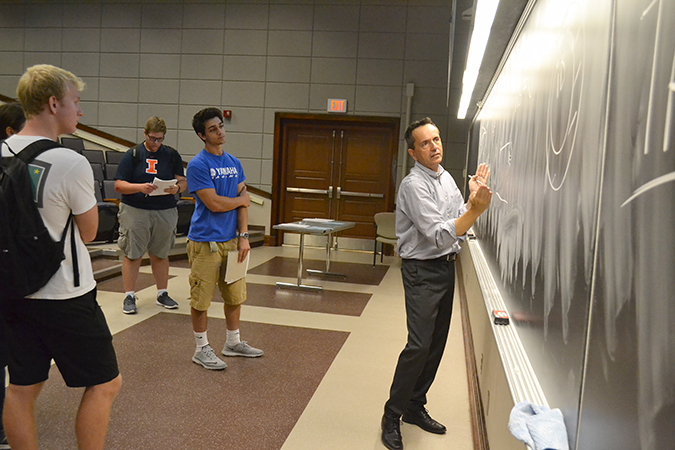
Professor Liebenberg explains a question after class.













.jpg)
















